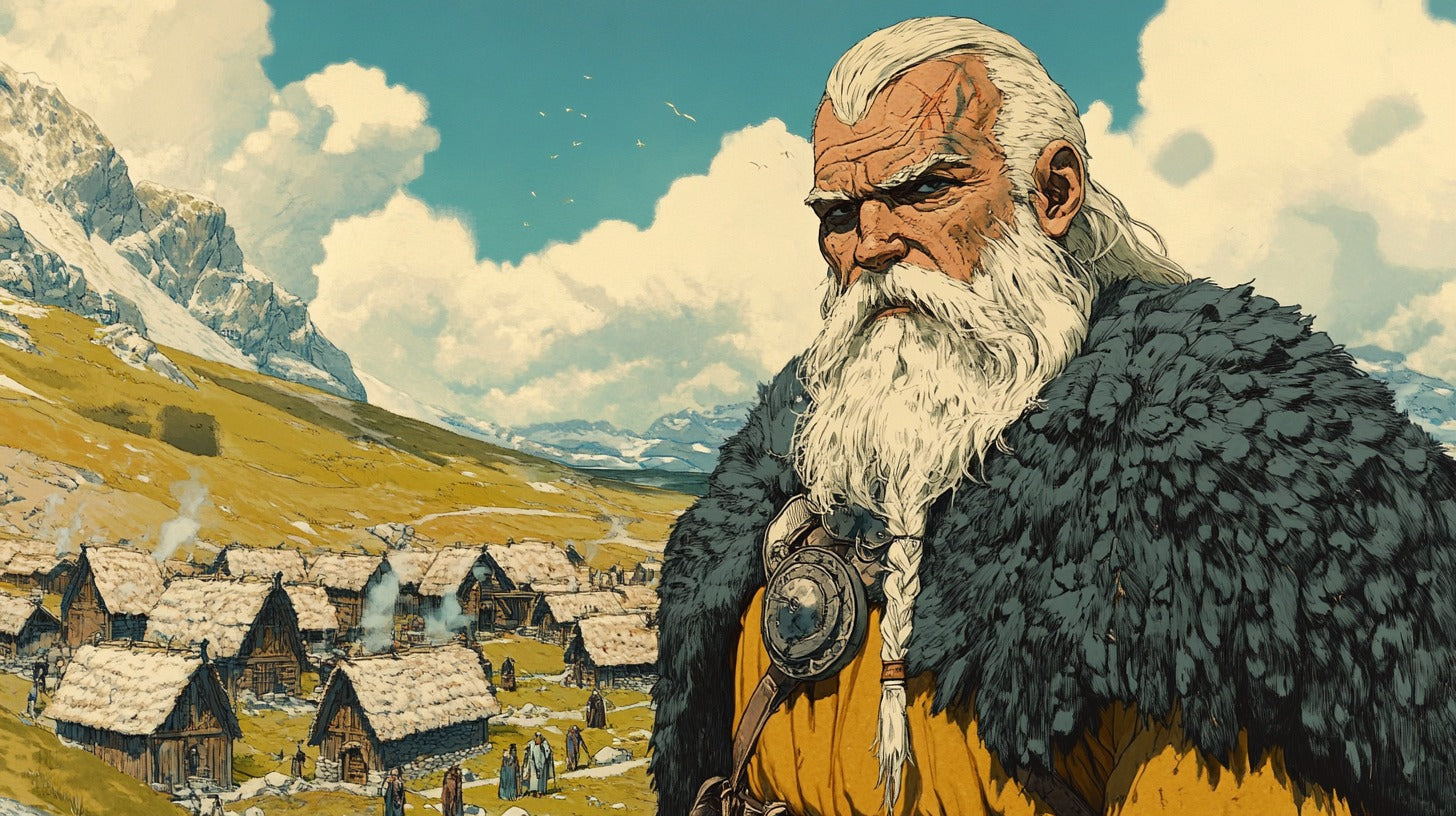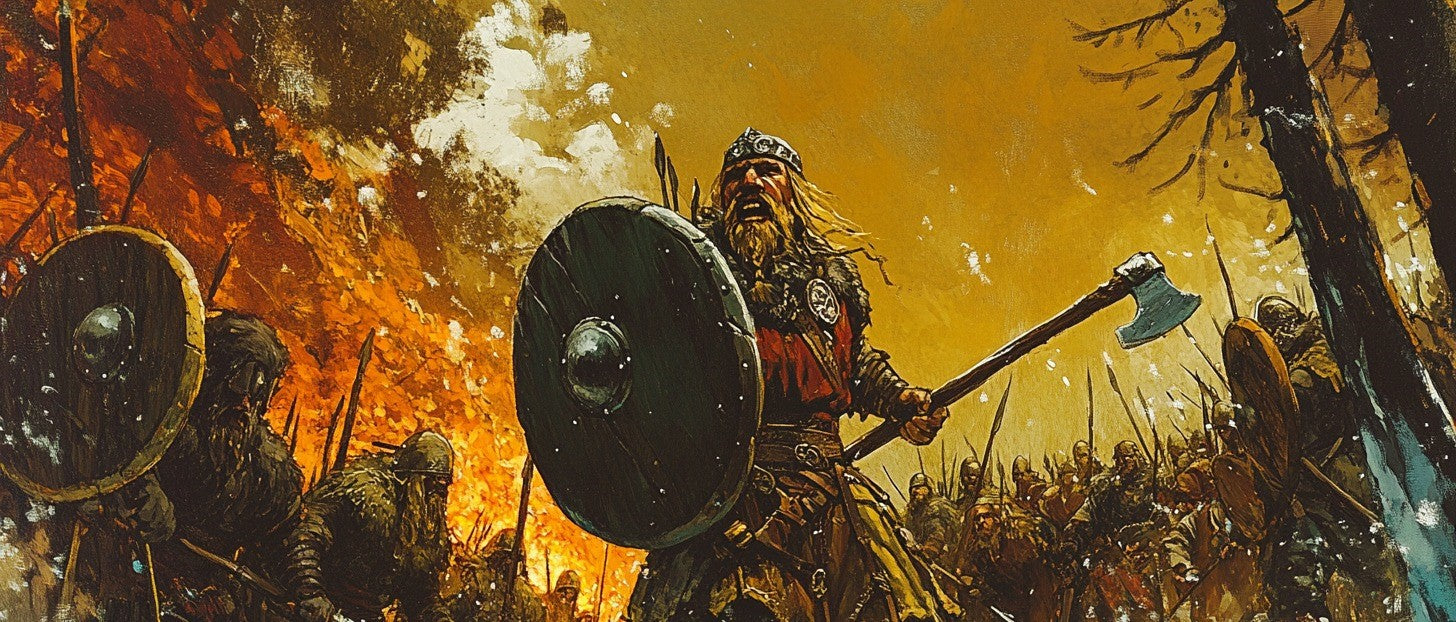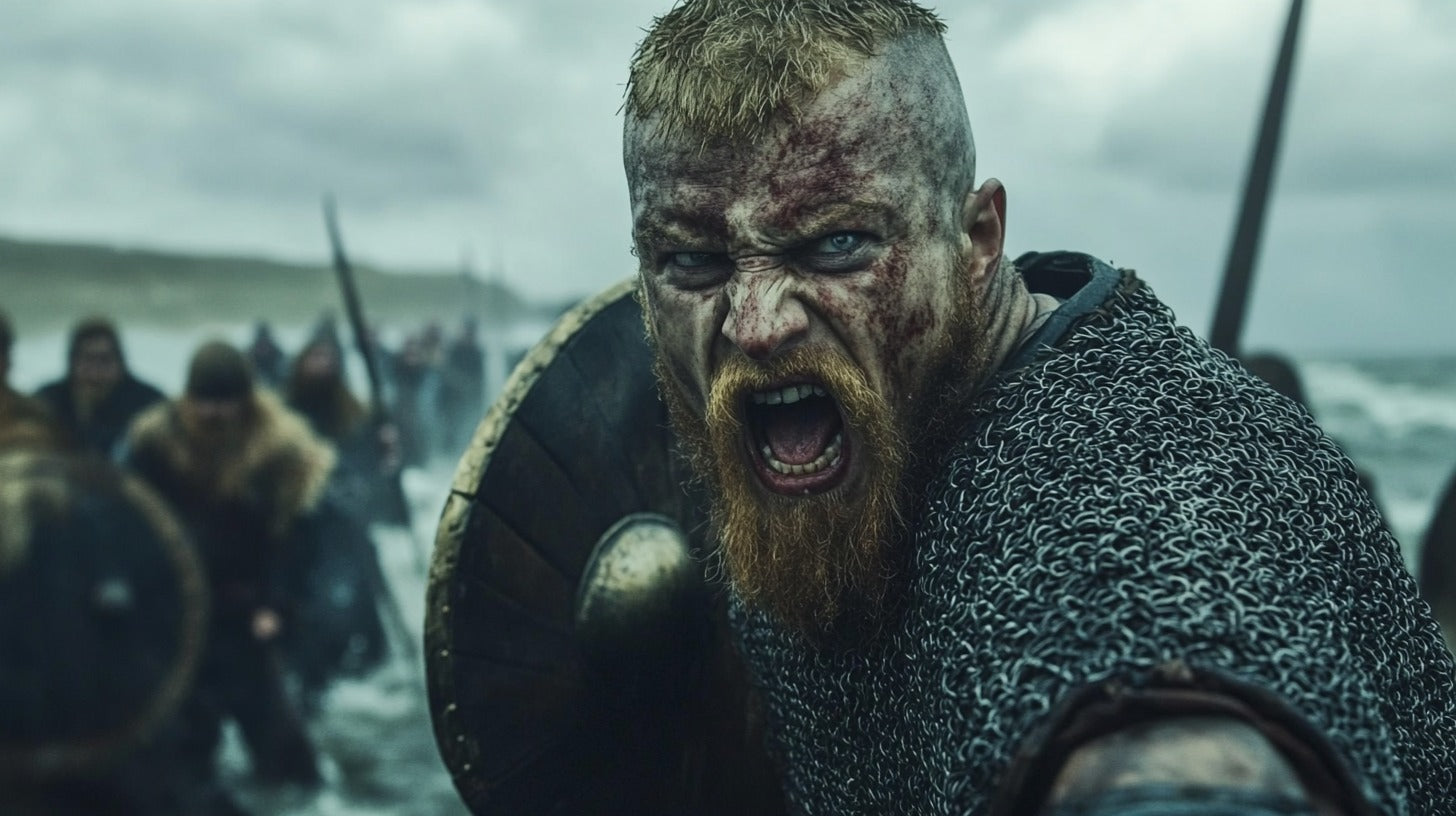
Jarls: The Mighty Lords of Viking Society
In the mist-shrouded fjords and windswept plains of ancient Scandinavia, a figure of immense power and influence held sway over the Norse people. Known as jarls, these formidable leaders stood as pillars of strength and authority in a society that valued courage, honor, and martial prowess above all else. But who were these jarls, and what role did they play in shaping the culture and history of the Viking Age? Let us embark on a journey through time to unravel the mysteries of these enigmatic figures and explore their lasting impact on the Norse world.
The Origins of Jarls

Etymology and Early Usage
The word "jarl" echoes through the ages, its very sound evoking images of bearded warriors and longships cutting through choppy seas. But where did this term originate? Like a tree with roots stretching deep into the soil of linguistic history, the word "jarl" can be traced back to the Proto-Norse erilaR, meaning "warrior" or "chieftain." As the languages of the North evolved, so too did this term, morphing into the Old Norse "jarl" we recognize today.
In the earliest days of Norse society, jarls were not necessarily born into their positions. Instead, they were often battle-hardened veterans who had proven their worth through feats of arms and cunning leadership. Picture a grizzled warrior, his face etched with the scars of countless battles, rising through the ranks to command the loyalty of his fellow Norsemen. This was the essence of the early jarl – a leader forged in the crucible of combat and respected for his strength and wisdom.
Evolution of the Jarl's Role
As Norse society grew more complex, so too did the role of the jarl. No longer simply a war chief, the jarl became a pivotal figure in the intricate web of Norse politics and governance. Imagine a spider at the center of its web, each silken strand representing a connection to various aspects of society – this was the jarl, deftly managing relationships with kings, other jarls, and the common folk alike.
The evolution of the jarl's role was not unlike the transformation of a caterpillar into a butterfly. What began as a simple position of military leadership blossomed into a multifaceted role encompassing administrative, judicial, and even religious responsibilities. As we delve deeper into the world of jarls, we'll explore each of these facets in turn, painting a vivid picture of their place in Norse society.
The Social Hierarchy of Norse Society

Kings, Jarls, and Karls
To understand the true significance of jarls, we must first comprehend the social structure in which they operated. Norse society was stratified, much like the layers of a richly decorated shield. At the top sat the king, gleaming like the shield's golden boss. Below him were the jarls, forming a strong and resilient layer of authority. Finally, the karls – free farmers and craftsmen – made up the bulk of society, like the sturdy wood forming the shield's base.
This tripartite division of society was more than mere happenstance; it was deeply ingrained in Norse mythology and worldview. The god Ríg, according to the Eddic poem Rígsþula, fathered the progenitors of these three social classes. This divine origin story lent an air of cosmic significance to the social order, with jarls occupying a crucial middle ground between royalty and commoners.
The Jarl's Position of Influence
Within this hierarchical structure, jarls wielded considerable influence. They were the lynchpins of Norse society, serving as intermediaries between the king and the people. Like a mighty oak tree stretching its branches both towards the sky and down to the earth, jarls connected the highest echelons of power with the grassroots of society.
Their position was one of both privilege and responsibility. Jarls enjoyed wealth, prestige, and authority, but they also shouldered the burden of maintaining order, dispensing justice, and defending their territories. It was a delicate balance, requiring the wisdom of Odin and the strength of Thor to navigate successfully.
Responsibilities and Powers of Jarls

Valknut Valor - Norse Warrior Ring
Military Leadership
At the heart of a jarl's duties lay the art of war. In a society that glorified martial prowess, jarls were expected to be skilled warriors and cunning strategists. Picture a jarl standing at the prow of a dragon-headed longship, his hair whipping in the salty wind as he leads his men on a daring raid. This was not mere romanticism – it was a fundamental aspect of the jarl's role.
Jarls commanded their own armies, known as leidang, which they could call upon in times of war or to defend their territories. They were responsible for training and equipping these forces, ensuring that their men were ready to face the challenges of battle. The relationship between a jarl and his warriors was often deeply personal, forged in the heat of combat and cemented by bonds of loyalty and mutual respect.
Administrative Duties
Yet the life of a jarl was not all blood and thunder. In times of peace, jarls played a crucial role in the day-to-day governance of their territories. Like a skilled juggler keeping multiple balls in the air, a jarl had to balance various administrative responsibilities.
These duties included collecting taxes, overseeing trade, and managing resources. Jarls were responsible for ensuring the prosperity of their regions, a task that required both shrewdness and foresight. They had to navigate the complex web of alliances and rivalries that characterized Norse politics, always working to maintain their position and expand their influence.
Judicial Authority
In addition to their military and administrative roles, jarls also served as judges and arbitrators. They presided over thing assemblies, where legal disputes were settled and important decisions were made. The thing was the beating heart of Norse democracy, and the jarl's role in these assemblies was crucial.
Imagine a jarl seated on a high seat, his brow furrowed in concentration as he listens to the arguments of two feuding parties. With the wisdom of Solomon, he must render judgments that are both fair and in keeping with Norse law and custom. This judicial authority was a cornerstone of the jarl's power, allowing him to shape the very fabric of society through his decisions.
The Jarl's Household and Retinue

Hirdmen and Personal Guards
A jarl was never alone. Surrounding him was a cadre of loyal followers known as hirdmen. These were more than mere bodyguards; they were the jarl's inner circle, his most trusted advisors and companions. The relationship between a jarl and his hird was like that between a wolf and its pack – bound by loyalty, mutual dependence, and a shared sense of purpose.
The hird lived and fought alongside their jarl, sharing in his triumphs and bearing the brunt of his defeats. They were the steel in the jarl's sword, the shield at his back, and the horn from which he drank. In return for their loyalty, hirdmen enjoyed a privileged position in Norse society, basking in the reflected glory of their lord.
Feasts and Hospitality
One of the most important duties of a jarl was to provide hospitality to visitors and to host lavish feasts for his followers. These gatherings were more than mere indulgences; they were vital social and political events that cemented alliances, settled disputes, and reinforced the jarl's status.
Picture a great hall, its rafters echoing with the sound of laughter and song. Long tables groan under the weight of roasted meats, fresh bread, and horns overflowing with mead. At the head of the table sits the jarl, presiding over the festivities like Odin himself. These feasts were a demonstration of the jarl's wealth and generosity, key virtues in Norse society.
Jarls in Norse Mythology and Sagas

Divine Connections
The importance of jarls in Norse society was reflected in their prominence in mythology and religious beliefs. According to some traditions, jarls were believed to have a special connection to the gods, particularly Odin, the ruler of Asgard. This divine association lent an air of sacred authority to the jarl's position.
In the grand tapestry of Norse mythology, jarls were often depicted as descendants of the gods or as individuals favored by divine powers. This celestial lineage served to legitimize their authority and reinforce their elevated status in society.
Legendary Jarls in Literature
The sagas and epic poems of Norse literature are replete with tales of legendary jarls. These stories, passed down through generations, served to inspire and instruct, providing models of leadership and valor for real-life jarls to emulate.
One such legendary figure was Jarl Haakon of Lade, a powerful ruler in Norway during the 10th century. His story, filled with political intrigue, battles against rival jarls and kings, and ultimately his downfall, reads like a Norse "Game of Thrones." These narratives not only entertained but also reinforced cultural values and expectations surrounding the role of jarls in society.
The Decline of Jarls and Their Legacy

Historic Norse settlement on the Brough of Birsay, Orkney Islands. This tidal islet, formerly connected to Mainland Orkney, showcases remnants of the early Norse rulers' stronghold / Photo: Stephen McKay, CC BY-SA 2.0
The Rise of Centralized Monarchy
As the Viking Age drew to a close and Scandinavian kingdoms became more centralized, the traditional role of jarls began to change. The rise of strong monarchies in Norway, Denmark, and Sweden meant that the semi-independent power of jarls was increasingly curtailed.
This transition was not unlike the changing of seasons. Just as summer gives way to autumn, the era of powerful, semi-autonomous jarls gradually faded. Kings sought to consolidate their power, bringing jarls more firmly under royal control and transforming them into appointed officials rather than semi-independent rulers.
Transformation into Earls and Nobles
Despite this decline, the legacy of jarls lived on. In many cases, the title and some of the functions of jarls were absorbed into new systems of nobility. In England, for example, the Old Norse "jarl" evolved into the title "earl," while in continental Europe, jarls often became counts or dukes.
This transformation was like a river changing its course. The flow of power and prestige that once ran through the institution of jarls found new channels, adapting to the changing political landscape while still carrying echoes of its Norse origins.
Conclusion: The Enduring Impact of Jarls on Scandinavian History
As we draw our exploration of jarls to a close, we can see that their impact on Norse society and beyond was profound and lasting. From their origins as warrior chiefs to their role as key figures in the complex political and social landscape of the Viking Age, jarls left an indelible mark on Scandinavian history.
The legacy of jarls can still be felt today, not just in the titles and traditions of European nobility, but in the enduring fascination with Norse culture and the Viking Age. The figure of the jarl – powerful, honorable, and deeply embedded in the fabric of society – continues to capture our imagination, reminding us of a time when leaders were forged in battle and bound by ancient codes of loyalty and honor.
As we look back through the mists of time at these formidable figures, we gain not only a deeper understanding of Norse society but also insights into the nature of leadership and the complex interplay between power, responsibility, and cultural values. The story of the jarls is, in many ways, the story of the Norse people themselves – a tale of strength, adaptability, and enduring influence that continues to resonate across the centuries.
FAQs
- Were all jarls of noble birth?
While many jarls came from established noble families, especially in later periods, it was possible for individuals to rise to the position of jarl through exceptional military or political achievements. The Norse valued merit alongside bloodline.
- How did the role of jarls differ from that of kings?
Jarls were powerful regional rulers, but they typically owed allegiance to a king. Kings had broader authority and were considered the highest earthly power, while jarls governed specific territories on behalf of or in cooperation with the monarch.
- Did female jarls exist in Norse society?
While rare, there are some historical references to women holding positions of power similar to jarls. However, the overwhelmingly martial nature of the role meant it was primarily held by men in Norse society.
- How did Christianity affect the institution of jarls?
The spread of Christianity in Scandinavia gradually altered the religious aspects of the jarl's role. While they maintained their political and military functions, the divine associations with Norse gods were replaced by Christian concepts of divinely ordained nobility.
- What happened to jarls after the Viking Age?








